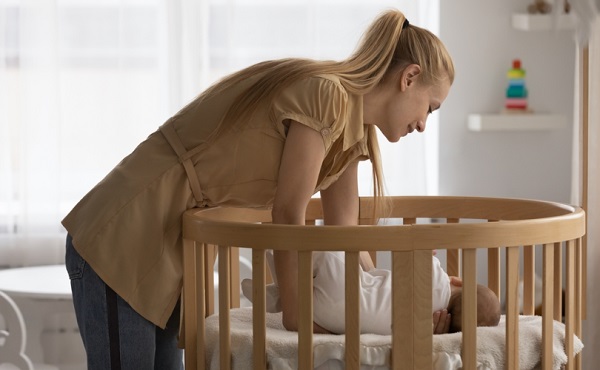Health
Police are charging parents with felonies for not placing infants who died in sleep on their backs

From LifeSiteNews
By Dr. Brenda Baletti, The Defender
Pennsylvania authorities brought felony charges against the parents of two different babies after police said the infants died because the parents placed them in unsafe sleeping positions.
Parents of two different babies are being charged with felonies in Pennsylvania after police say their babies died because the parents placed them in unsafe sleeping positions, SpotlightPA reported.
In both cases, police allege that the parents failed to follow guidance, including handouts given to them at doctor’s visits, stating that babies should be put to sleep on their backs.
Gina and David Strause of Lebanon County are accused of putting their 3-month-old infant son, Gavin, to sleep on his stomach and allowing him to sleep with stuffed animals in the crib.
They are charged with involuntary manslaughter, recklessly endangering another person, and endangering the welfare of children.
Natalee Rasmus of Luzerne County is accused of putting her 1-month-old daughter, Avaya Jade Rasmus-Alberto, to sleep on her stomach on a boppy pillow, often used for nursing. She is charged with third-degree murder, involuntary manslaughter, and endangering the welfare of children.
Rasmus was a 17-year-old mother when her daughter died in 2022. Court records show that she continues to be held at the Luzerne County Correctional Facility with bail set at $25,000 pending resolution of her case.
In both cases, autopsies concluded the babies died of accidental death from asphyxiation. Law enforcement argued in both cases that parents should have known that putting the babies to sleep on their stomachs was unsafe, because they had received paperwork at wellness visits informing them of safe sleeping practices.
They pointed to signed acknowledgements in the babies’ medical records that were created as part of a 2010 state law to educate parents about Sudden Infant Death Syndrome (SIDS).
The law requires hospitals, birthing centers, and medical providers to give parents educational materials from the national Safe to Sleep campaign, and ask them to certify that they received them.
Signing the statement is voluntary. The statement doesn’t indicate that parents can be charged with a criminal offense if they don’t follow the campaign advice.
Advocates from national organizations that educate parents about safe sleep practices found the charges shocking. Nancy Maruyama, the executive director of Sudden Infant Death Services of Illinois, told Spotlight PA, “To charge them criminally is a crime, because they have already suffered the worst loss.”
Alison Jacobson, executive director of First Candle, a non-profit that also educates parents about safe sleep practices, told Pennlive, “There is no law against placing a baby on his or her stomach to sleep. How they can charge this family with involuntary manslaughter is completely baffling to me.”
Researcher Neil Z. Miller, an expert on SIDS and the Safe to Sleep campaign, told The Defender, “Parents of a sleeping baby who dies in the middle of the night should never be charged with murder. That’s just cruel.”
Miller, author of “Vaccines: Are They Really Safe and Effective?” added:
Should parents be obligated to follow every “recommendation” made by their doctor or the Safe to Sleep campaign? Would we as a society prefer that doctors raise our babies instead of the parents? Have other possible causes of death been considered, such as vaccinations? As a society, we can, and must, do much better.
Does placing infants on their backs make a difference?
The handouts shared with new Pennsylvania parents are based on the National Institutes of Health “Safe to Sleep” campaign, which institutionalized a program initiated by the American Academy of Pediatrics (AAP) in 1992 to inform parents to put children to sleep on their backs rather than on their stomachs.
The campaign is based on the premise that babies who sleep on their backs or sides are less likely to die in their sleep. Until that time, it was common for babies to sleep on their stomachs.
The program was launched in the wake of a rising number of SIDS deaths – and growing concern among some parents that the deaths were linked to vaccination.
In a 2021 article in the peer-reviewed journal Toxicology Reports, vaccine researcher Neil Z. Miller provides a history of the SIDS diagnosis, noting that the rise of SIDS coincided with the first mass immunization campaigns.
Between 1992, when the Safe to Sleep program launched, and 2001, SIDS deaths reportedly declined a whopping 55 percent – a number touted in articles celebrating the program, making it appear that babies sleeping on their stomachs was the cause of SIDS, not vaccines.
However, at the same time deaths from SIDS decreased, the rate of mortality from “suffocation in bed,” “suffocation other,” “unknown and unspecified causes,” and “intent unknown” all increased significantly.
Why? The classification system had changed. SIDS deaths were being reclassified by medical certifiers, usually coroners, as one of the other similar categories, not SIDS.
Research published in the journal Pediatrics, the AAP’s flagship journal, concluded that deaths previously certified as SIDS were simply being certified as other non-SIDS causes, such as suffocation – but the deaths were still essentially SIDS deaths.
That change in classification accounted for more than 90 percent of the drop in SIDS rates.
The Pediatrics paper showed no decline in overall postneonatal mortality after the Safe to Sleep campaign was launched, despite the program’s – and the AAP’s – claims to the contrary.
Others verified the Pediatrics paper’s findings, and the trend continued, as reported by multiple studies in top journals. Miller reported that, for example, “From 1999 through 2015, the U.S. SIDS rate declined 35.8% while infant deaths due to accidental suffocation increased 183.8%.”
Research shows that almost 80 percent of SIDS deaths reported to the Vaccine Adverse Event Reporting System (VAERS) happen within seven days of vaccination.
Theories linking vaccines to SIDS suggest that, in some cases, underdeveloped liver enzyme pathways may make it harder for some infants to process toxic ingredients in vaccines. Others argue that other, multiple, complex factors can make some infants vulnerable to toxic ingredients in vaccines.
Baby Gavin was ‘a dream come true’
On April 30, Gina and David Strause were charged with involuntary manslaughter, which carries a sentence of up to 10 years, and other lesser charges in the death of their son, Gavin.
According to the police report, Gina found her son unresponsive, cold, and blue in his crib when she woke up to feed him on the morning of May 8, 2024. She immediately called 911 and performed CPR until the police arrived.
The baby was pronounced dead at the hospital. The autopsy report found the cause of death to be “complications of asphyxia.”
Police said they observed loose items in the crib, “such as blankets and stuffed animals.”
Gina said that after feeding her baby at about 11:30 p.m. the night before he died, she placed him in his crib on his belly, because he was a “belly sleeper,” and covered him with a blanket. She said that she had received the recommendation that he should sleep on his back, but that he preferred to sleep on his stomach.
In an interview with Pennlive, Gina said that she typically put Gavin to sleep on his back, but he had gotten into the daily habit of rolling onto his belly.
Davis Stause told police that when he left for work at 5:30 a.m., he checked on Gavin, who was sleeping on his stomach and moving around a little bit. David said he “patted his butt” to put him back to sleep.
The police reported that they also obtained medical records from birth through death that showed that on the discharge paperwork that the parents received information about safe sleep practices, which included putting the baby on its back, having it sleep in the same room as the parents, and keeping the crib clear of bumper pads and stuffed animals.
They said this paperwork explained how parents could create a safe sleeping environment for their babies to reduce the risk of SIDS.
Baby Gavin also went to the pediatrician for well-child visits on February 7 and 14, March 5, and April 9, a month before he died.
Gina told Pennlive that Gavin, who was born when she was almost 40, was “a dream come true.” She had taken 10 weeks of maternity leave and largely worked at home to spend as much time with him as possible. She said that after she gave birth, she was “overwhelmed” and didn’t remember receiving any paperwork or instructions about sleep.
Gina also said that at the hospital, police treated her and her husband with immediate suspicion, separating and questioning them. They were not allowed to see their baby again before he was taken by the coroner’s office.
The parents created a GoFundMe page, where they shared a copy of the police report, to help cover their legal costs, because they said they do not qualify for a public defender.
The Defender attempted to contact the parents to inquire about the baby’s overall health, if he had any medical conditions, was born prematurely, or had recently received any vaccines, but the parents did not respond by deadline.
The district attorney’s office also did not respond to requests for comment.
‘Tragic accident with no criminal intent to harm or kill the baby’
The forensic pathologist who performed the autopsy for Natalee Rasmus’ baby listed the cause of death as accidental. According to the report, the baby died from asphyxiation, the Times Leader reported.
Rasmus discovered her baby had died on the morning of October 23, 2022, when she picked her up to get her ready for a doctor’s appointment.
Pennsylvania State Police in December charged Rasmus, alleging that she placed her baby face down to sleep against the recommendations of medical personnel and prenatal classes at Geisinger Wyoming Valley Medical Center.
At a preliminary hearing on the case in February, a state trooper testified that Rasmus ignored safe sleeping practices because she had placed her baby face down in her bassinet with a Boppy pillow, which has a tag warning, “Do not use for sleeping.”
The trooper, Caroline Rayeski, also testified that a search of Rasmus’ cell phone found that she had searched the internet to see whether it was ok to allow newborns to sleep on their stomachs. The trooper also seized literature from the prenatal classes stating it is “recommended” to put newborns to sleep on their backs.
“Yeah, she wouldn’t sleep, she’ll just scream, so she has to be like propped up,” Rasmus told the investigating officer, according to Spotlight PA, which reported the story.
Assistant attorneys argued in a preliminary hearing that she disregarded safe sleeping practices, and a judge forwarded the criminal case to county court.
Rasmus is being represented by public defenders Joseph Yeager and Melissa Ann Sulima, who told the Times Leader the baby’s death was “a tragic accident with no criminal intent to harm or kill the baby.”
Yeager said the prenatal literature referring to newborn sleep positions are “recommendations,” not mandates.
“As the death certificate says, it was an accident. Clearly, there was no malice in this accidental death,” said Yeager, who also said the case should be dismissed.
Rasmus’ most serious charge, third-degree murder, is a homicide that involves killing someone without intent to kill, but with reckless disregard for human life. In Pennsylvania, it can carry a prison sentence of up to 40 years.
Court documents indicate that Rasmus remains in jail with a $25,000 bail, pending the outcome of her case. Neither the district attorney nor Rasmus’ attorneys responded to The Defender’s request for comment.
How common is it to bring criminal charges against parents in infant deaths?
Attorney Daniel Nevins told SpotlightPA it is extremely rare for parents to be criminally charged when infants die after sleeping on their stomachs, and that the burden of proof on the prosecutors will be high.
In 2014, Virginia resident Candice Christa Semidey, age 25, was charged with murder after she swaddled her baby and put it to sleep on its stomach, the Washington Post reported. In that case, police similarly did not think that she intended for the baby to die.
She pleaded guilty to involuntary manslaughter and child neglect. She was ordered to serve three years of probation to avoid the five-year prison term she was sentenced to.
Some charges have also been brought against parents in deaths of infants sleeping with Boppy pillows. There have also been several cases of parents charged for sleeping in the same bed as their child.
The Defender recently reported on three SIDS deaths that occurred shortly after vaccination. Police are still investigating the parents of 18-month-old twins who died together a week after receiving three vaccines. Authorities have not yet charged the parents, but initially said they were investigating the deaths as homicides.
Blessings Myrical Jean Simmons, age 6 months, received six routine vaccines at a well-baby visit on January 13. The next morning, her parents found the baby dead in her bassinet. The autopsy lists SIDS as the infant’s cause of death, and no charges were filed against the parents.
This article was originally published by The Defender — Children’s Health Defense’s News & Views Website under Creative Commons license CC BY-NC-ND 4.0. Please consider subscribing to The Defender or donating to Children’s Health Defense.
Business
RFK Jr. planning new restrictions on drug advertising: report

Quick Hit:
The Trump administration is reportedly weighing new restrictions on pharmaceutical ads—an effort long backed by Health Secretary Robert F. Kennedy Jr. Proposals include stricter disclosure rules and ending tax breaks.
Key Details:
-
Two key proposals under review: requiring longer side-effect disclosures in TV ads and removing pharma’s tax deduction for ad spending.
-
In 2024, drug companies spent $10.8 billion on direct-to-consumer ads, with AbbVie and Pfizer among the top spenders.
-
RFK Jr. and HHS officials say the goal is to restore “rigorous oversight” over drug promotions, though no final decision has been made.
Diving Deeper:
According to a Bloomberg report, the Trump administration is advancing plans to rein in direct-to-consumer pharmaceutical advertising—a practice legal only in the U.S. and New Zealand. Rather than banning the ads outright, which could lead to lawsuits, officials are eyeing legal and financial hurdles to limit their spread. These include mandating extended disclosures of side effects and ending tax deductions for ad spending—two measures that could severely limit ad volume, especially on TV.
Health and Human Services Secretary Robert F. Kennedy Jr., who has long called for tougher restrictions on drug marketing, is closely aligned with the effort. “We are exploring ways to restore more rigorous oversight and improve the quality of information presented to American consumers,” said HHS spokesman Andrew Nixon in a written statement. Kennedy himself told Sen. Josh Hawley in May that an announcement on tax policy changes could come “within the next few weeks.”
The ad market at stake is enormous. Drugmakers spent $10.8 billion last year promoting treatments directly to consumers, per data from MediaRadar. AbbVie led the pack, shelling out $2 billion—largely to market its anti-inflammatory drugs Skyrizi and Rinvoq, which alone earned the company over $5 billion in Q1 of 2025.
AbbVie’s chief commercial officer Jeff Stewart admitted during a May conference that new restrictions could force the company to “pivot,” possibly by shifting marketing toward disease awareness campaigns or digital platforms.
Pharma’s deep roots in broadcast advertising—making up 59% of its ad spend in 2024—suggest the impact could be dramatic. That shift would mark a reversal of policy changes made in 1997, when the FDA relaxed requirements for side-effect disclosures, opening the floodgates for modern TV drug commercials.
Supporters of stricter oversight argue that U.S. drug consumption is inflated because of these ads, while critics warn of economic consequences. Jim Potter of the Coalition for Healthcare Communication noted that reinstating tougher ad rules could make broadcast placements “impractical.” Harvard professor Meredith Rosenthal agreed, adding that while ads sometimes encourage patients to seek care, they can also push costly brand-name drugs over generics.
Beyond disclosure rules, the administration is considering changes to the tax code—specifically eliminating the industry’s ability to write off advertising as a business expense. This idea was floated during talks over Trump’s original tax reform but was ultimately dropped from the final bill.
Alberta
Alberta pro-life group says health officials admit many babies are left to die after failed abortions

From LifeSiteNews
Alberta’s abortion policy allows babies to be killed with an ‘induced cardiac arrest’ before a late-term abortion and left to die without medical care if they survive.
A Canadian provincial pro-life advocacy group says health officials have admitted that many babies in the province of Alberta are indeed born alive after abortions and then left to die, and because of this are they are calling upon the province’s health minister to put an end to the practice.
Official data from the Canadian Institute for Health Information (CIHI), which is the federal agency in charge of reporting the nation’s health data, shows that in Alberta in 2023-2024, there were 133 late-term abortions. Of these, 28 babies were born alive after the abortion and left to die.
As noted by Prolife Alberta’s President Murray Ruhl in a recent email, this means the reality in the province is that “some of these babies are born alive… and left to die.”
“Babies born alive after failed late-term abortions are quietly abandoned—left without medical help, comfort, or even a chance to survive,” noted Ruhl.
This fact was brought to light in a recent opinion piece published in the Western Standard by Richard Dur, who serves as the executive director of Prolife Alberta.
Ruhl observed that Dur’s opinion piece has “got the attention of both Alberta Health Services (AHS) and Acute Care Alberta (ACA),” whom he said “confirmed many of the practices we exposed.”
Alberta’s policy when it comes to an abortion committed on a baby older than 21 weeks allows that all babies are killed before being born, however this does not always happen.
“In some circumstances… the patient and health practitioner may consider the option of induced fetal cardiac arrest prior to initiating the termination procedures,” notes Alberta Health Services’ Termination of Pregnancy, PS-92 (PS-92, Section 6.4).
Ruhl noted that, in Alberta, before an “abortion begins, they stop the baby’s heart. On purpose. Why? Because they don’t want a live birth. But sometimes—the child survives. And what then?”
When it comes to the same policy for babies older that 21 weeks, the policy states, “For terminations after 21 weeks and zero (0) days there must be careful consideration and documentation concerning a Do Not Resuscitate order in anticipation of a possible live birth.” (PS-92, Section 6.4).”
Ruhl observed that the reality is, “They plan in advance not to save her—even if she’s born alive.”
If the baby is born alive, the policy states, “Comfort measures and palliative care should be provided.” (PS-92, Section 6.4).
This means, however, that there is no oxygen given, no NICU, “no medical care,” noted Ruhl.
“Their policies call this ‘palliative care.’ We call it what it is: abandonment. Newborns deserve care—not a death sentence,” he noted.
As reported by LifeSiteNews recently, a total of 150 babies were born after botched abortions in 2023-2024 in Canada. However, it’s not known how many survived.
Only two federal parties in Canada, the People’s Party of Canada, and the Christian Heritage Party, have openly called for a ban on late abortions in the nation.
Policy now under ‘revision’ says Alberta Health Services
Ruhl said that the province’s policies are now “under revision,” according to AHS.
Because of this, Ruhl noted that now is the time to act and let the province’s Health Minister, Adriana LaGrange, who happens to be pro-life, act and “demand” from her real “action to protect babies born alive after failed abortions.”
The group is asking the province to do as follows below:
- Amend the AHS Termination of Pregnancy policy to require resuscitative care for any baby born with signs of life, regardless of how the birth occurred.
- Require that these newborns receive the same level of care as any other premature baby. Newborns deserve care—not a death sentence.
- Recognize that these babies have a future—there is a literal waiting list of hundreds of families ready to adopt them. There is a home for every one of them.
While many in the cabinet and caucus of Alberta Premier Danielle Smith’s United Conservative government are pro-life, she has still been relatively soft on social issues of importance to conservatives, such as abortion.
-

 Alberta2 days ago
Alberta2 days agoCentral Alberta MP resigns to give Conservative leader Pierre Poilievre a chance to regain a seat in Parliament
-

 Alberta2 days ago
Alberta2 days agoCalls for a new pipeline to the coast are only getting louder
-

 Daily Caller2 days ago
Daily Caller2 days ago‘Not Held Hostage Anymore’: Economist Explains How America Benefits If Trump Gets Oil And Gas Expansion
-

 Business2 days ago
Business2 days agoCanada’s economic pain could be a blessing in disguise
-

 Censorship Industrial Complex1 day ago
Censorship Industrial Complex1 day agoJordan Peterson reveals DEI ‘expert’ serving as his ‘re-education coach’ for opposing LGBT agenda
-

 Alberta2 days ago
Alberta2 days agoAlberta pro-life group says health officials admit many babies are left to die after failed abortions
-

 Alberta1 day ago
Alberta1 day agoUnified message for Ottawa: Premier Danielle Smith and Premier Scott Moe call for change to federal policies
-

 Economy1 day ago
Economy1 day agoOttawa’s muddy energy policy leaves more questions than answers






